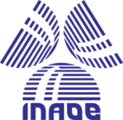Por favor, use este identificador para citar o enlazar este ítem:
http://inaoe.repositorioinstitucional.mx/jspui/handle/1009/2723| Cross Spectral Density Propagated Throught a Circular Aperture in the Fresnel Approximation | |
| JOSE GUADALUPE SUAREZ ROMERO | |
| Eduardo Tepichin | |
| Acceso Abierto | |
| Atribución-NoComercial-SinDerivadas | |
| Spectral Density Fresnel Fraunhofer Polar coordinates numerical calculations Cittert-Zernike Theorem | |
| La labor principal de un laboratorio nacional de metrología es la de establecer las unidades del sistema de medición de su país. Para el caso de México, el laboratorio en cuestión es el centro nacional de metrología (CENAM), y el sistema adoptado es el sistema internacional de unidades (SI). En particular la radiometría se encarga de establecer las unidades de medición de variables ópticas. Las magnitudes radiométricas que nos interesan en este trabajo son la radiancia [W/(c m2 sr)] y la irradiancia [W/cm2], las cuales serán implementadas en el CENAM. Un patrón primario de radiancia es el radiador de cuerpo negro. Su radiancia es conocida y esta dada por la ley de Plank. Sin embargo un radiador de cuerpo negro es un instrumento costoso tanto en su adquisición como en su operación. Además, la estabilidad que éste alcanza en su emisión limita la incertidumbre que se puede alcanzar en las mediciones. Un sistema alterno para materializar una escala de radiancia es mediante un banco radiométrico con dos aberturas. The main task of a National Laboratory of Metrology is to establish, to preserve and to offer benchmarks for measurement, in industry and commerce. For radiometric measurements one also needs to establish a benchmark. The goal for establishing a radiometric standard is to understand the use of limiting apertures within an optical system. The use of those apertures is necessary to eliminate the stray light and to specify a measurement surface on a detector. For example, the radiance of a lamp can be measured with the help of a detector. We need to know the response of the detector as well as geometrical parameters: as the detection surface, the solid angle, the radiating surface of the lamp, distances, etc. All these parameters can be established with the help of apertures. According to geometrical optics, an aperture selects a set of rays (coming from the source) into an illuminated zone and a shadow zone. Hence the illuminated zone is the geometrical projection of the aperture, see Fig. 1.1. If we assume an isotropic angular distribution (of the rays coming from the source), then the bright zone is uniformly illuminated. One can observe experimentally that along the projection of the edges, there is a penumbra. | |
| Instituto Nacional de Astrofísica, Óptica y Electrónica | |
| 1999-12 | |
| Tesis de doctorado | |
| Inglés | |
| Estudiantes Investigadores Público en general | |
| Suárez Romero, J. G., (1999), Cross Spectral Density Propagated Throught a Circular Aperture in the Fresnel Approximation, Tesis de Doctorado, Instituto Nacional de Astrofísica, Óptica y Electrónica. | |
| ÓPTICA | |
| Versión aceptada | |
| acceptedVersion - Versión aceptada | |
| Aparece en las colecciones: | Doctorado en Óptica |
Cargar archivos:
| Fichero | Tamaño | Formato | |
|---|---|---|---|
| SUAREZRJG_MO.pdf | 362.91 kB | Adobe PDF | Visualizar/Abrir |
